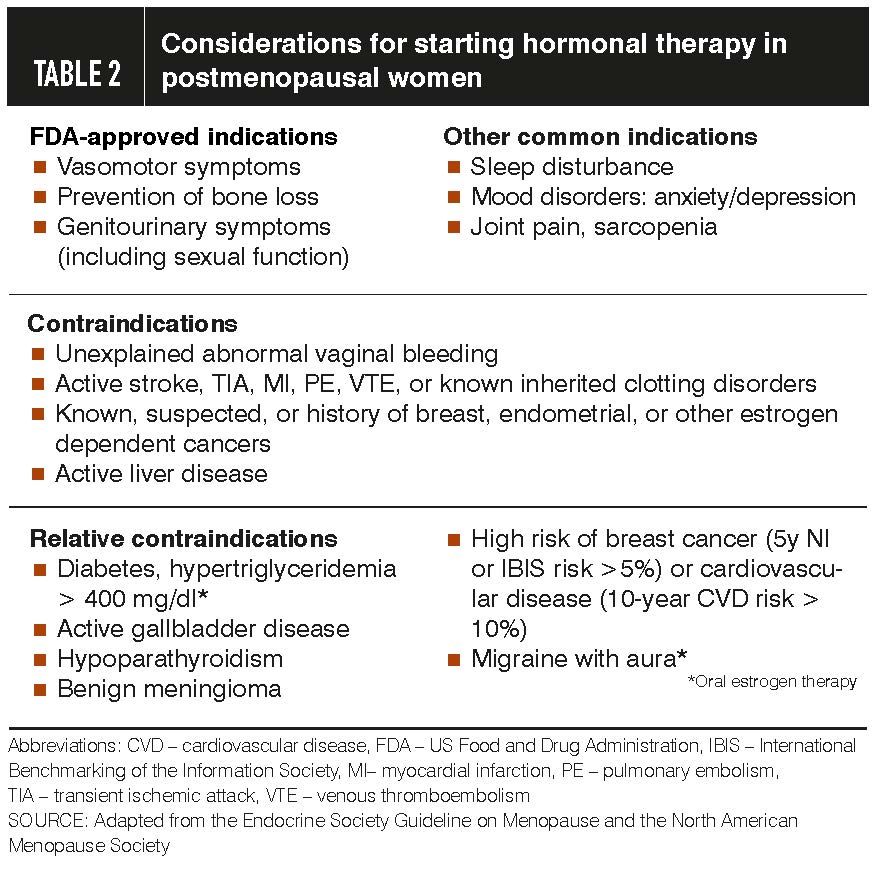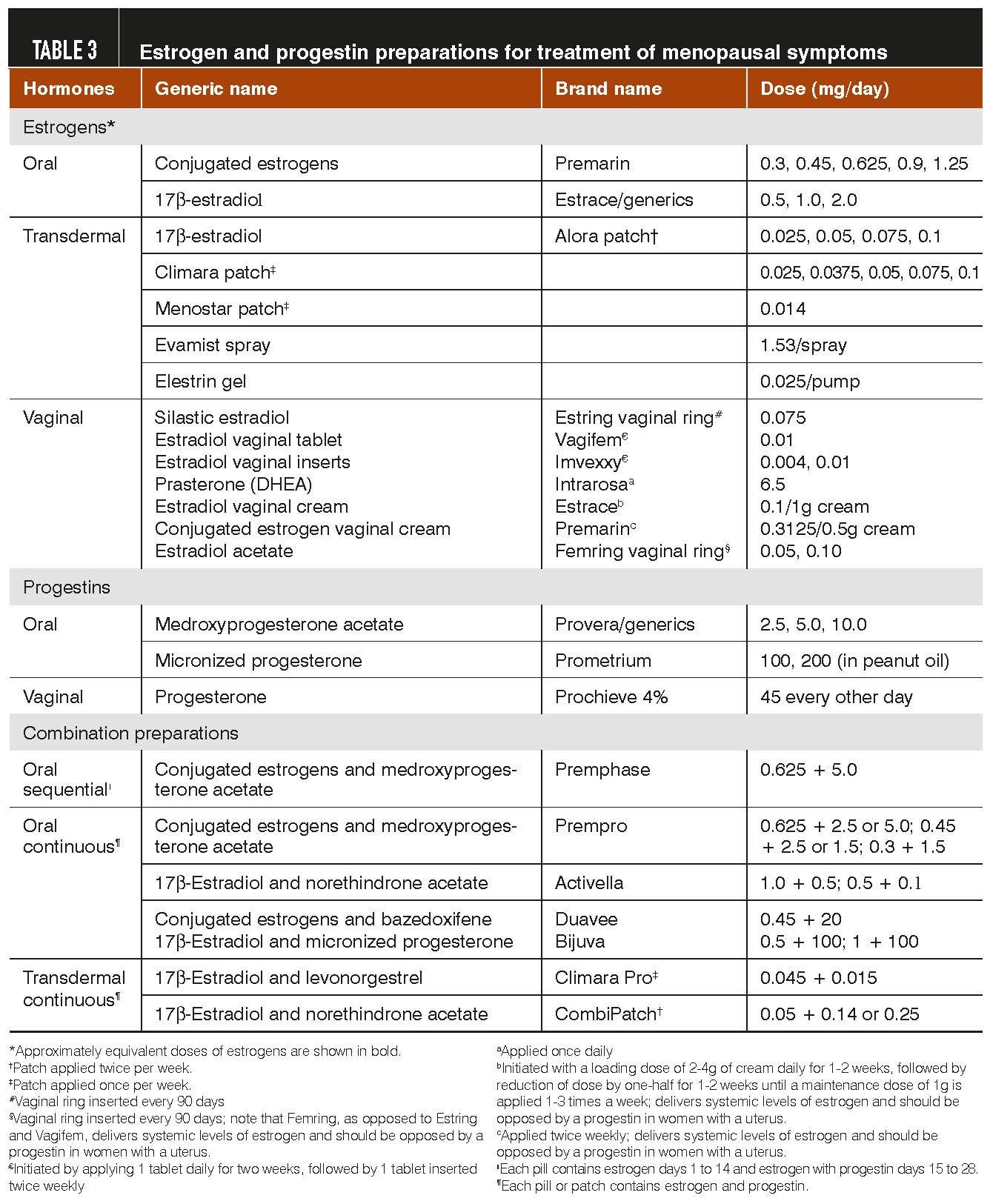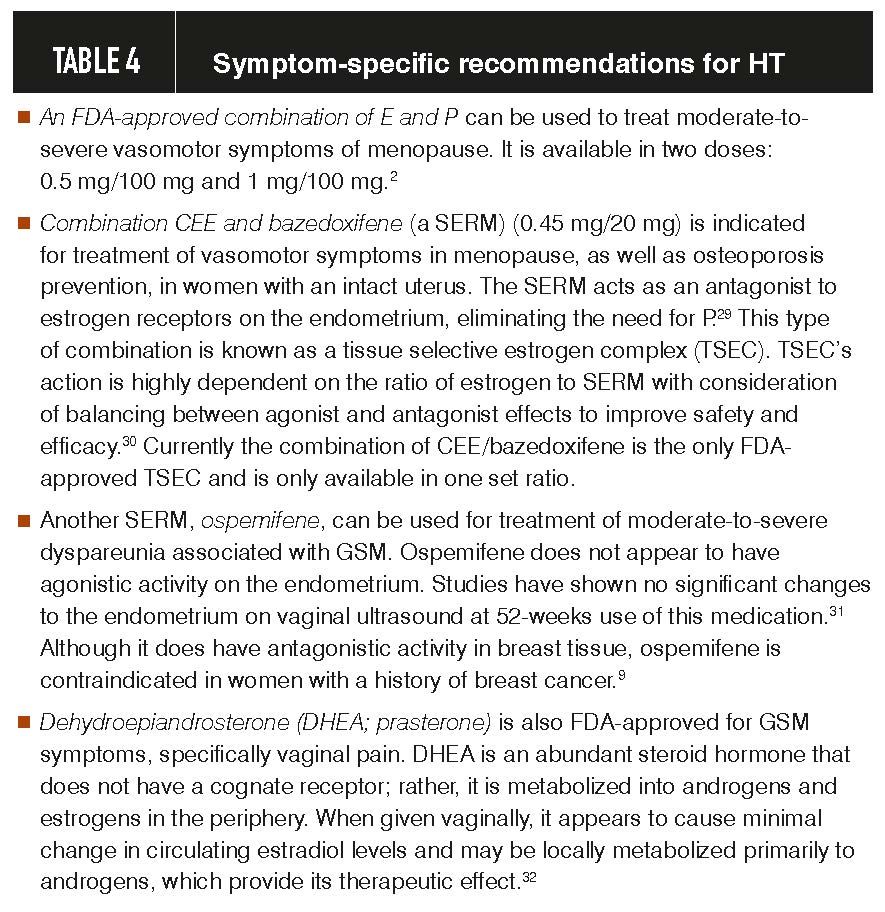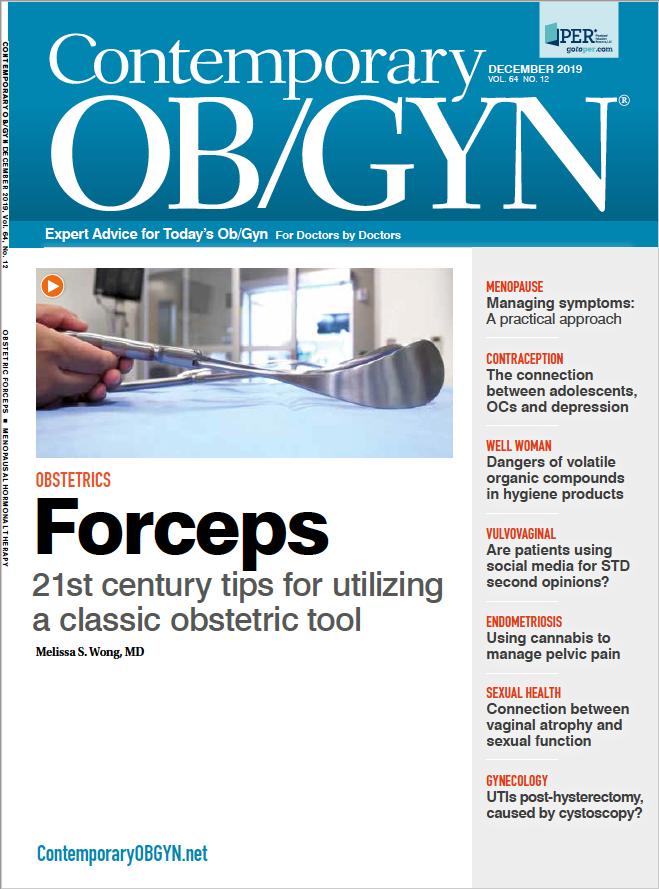Practical approach to managing menopause
Hormonal therapy is not without controversy but it is still one of the most effective treatments for patients with symptoms.
©STUDIO GRAND WEB - stock.adobe.com

Table 1

Table 2

Most women who traverse menopause experience significant symptoms and many require at least temporary pharmacological treatment for maintenance of quality of life. Despite the controversy surrounding it, hormone therapy (HT) with either estrogen alone (E) or estrogen plus progestin (E+P) remains the most effective treatment for menopausal symptoms. This article provides a brief history of menopausal hormone therapy (HT) and discusses practical aspects of treatment and discontinuation.
HT from the 1950s to WHI
HT has had a cyclical history of high acceptance and uptake, followed by reduced use related to emergence of risk. Its efficacy for symptoms was recognized in the 1950s and 1960s.1 Shortly thereafter, increased risk of endometrial cancer associated with E preparations was followed by the addition of progestin to regimens for women with a uterus, and a transient reduction in enthusiasm for HT.2
In the 1980s, the strong observational association between hormone use and reduced risk of coronary heart disease (CHD)3 led to exploration of systemic benefits of HT beyond symptom relief, which triggered another surge in use. However, when the effectiveness of HT as a preventive medication was tested in a randomized clinical trial, the Women’s Health Initiative (WHI), there was no observed reduction in CHD in women with or without a uterus, and a small signal for initial harm emerged, with differential risks depending upon whether a woman had a uterus and was randomized to E+P or had a hysterectomy and therefore took E Alone (Table 1).4,5 Differences in treatment with E+P compared to E alone reveal an elevated risk of CHD, venous thromboembolism (VTE), breast cancer in the E+P arm and no risk for breast cancer in the E-only arm (Table 1). The association between breast cancer in the E+P arm was further corroborated by an 11-year follow-up study among participants of the WHI study, which demonstrated a small increase in breast cancer incidence (HR, 1.25 [95%CI 1.07-1.46; P = 0.004]) and mortality (HR, 1.96 [95%CI: 1.00-4.04, P = 0.49]).6 After publication of these findings, HT prescriptions dropped by 32% overall with a > 60% drop in prescriptions for conjugated equine estrogen (CEE)/medroxyprogesterone acetate (MPA).7
Based upon these findings, HT is not recommended for preventive use by The American College of Obstetricians and Gynecologists, the Endocrine Society, or the North American Menopause Society (Table 2).8-10 Despite its rigor, the WHI was designed in the late 1980s and was constructed to test the hypothesis that CHD would be prevented by the then-commonly-used preparation of CEE plus MPA (in women with a uterus) or CEE alone in women without a uterus. Subclinical coronary disease was not considered in participant recruitment, and women were stratified into 10-year age bins that included many women who would otherwise not be taking HT for current indications (i.e., symptom relief). This makes some of the endpoints difficult to interpret when advising a current patient in her early 50s who requires symptom control.
Current evidence from WHI and other trials
More recent follow-up of women who participated in the WHI, now 17 years after its original outcome publication, provide a very reassuring perspective on the long-term harms and benefits of exposure to HT for women in different age groups, and can be helpful for clinicians in guiding their recommendations.11,12 Studies subsequent to the WHI have examined a series of
intermediate endpoints to help explain the discrepancy between the WHI and observational studies, specifically the Nurses’ Health Study,3 with respect to the outcome of CHD. When the WHI data are limited to women in the youngest age group (50-59), there is no increased risk of CHD associated with HT. Follow-up studies such as the Kronos Early Estrogen Prevention Study (KEEPS) provided similar reassurance about the safety of “early initiation” of HT with respect to carotid intimal medical thickness (CIMT) and coronary calcium scores. The Late Intervention Trial with Estradiol (ELITE) study demonstrated reduced CIMT accrual with early initiation of HT following menopause and minimal cardiovascular effects with later treatment initiation compared to placebo.13,14 Taken together, these findings support the notion that use of HT in women who are in the early postmenopause does not confer CHD risk, and may be of some benefit.
Indications for HT
Because of its unmatched effectiveness, HT is the treatment of choice for many symptomatic women, and more recent review of clinical guidelines indicates situations in which extended use for more than just a few years can be considered (as opposed to the “lowest possible dose for the shortest possible time”) after informed, shared decision-making.
While hot flashes and night sweats are the most prevalent symptoms of menopause, vaginal dryness or genitourinary syndrome of menopause (GSM), adverse mood (depression and/or anxiety), and poor sleep are additional clinical complaints that are attributable to menopause and likely to be relieved by HT.15 This is not an all-encompassing list of symptoms, however, and clinicians may consider a 3- to 6-month empiric trial of HT for atypical symptoms that appear strongly related to menopause. If HT is ineffective, it should be stopped, and other causes and treatments will need to be considered.
Common indications for initiating hormonal therapy in women include vasomotor symptoms (VMS) and genitourinary dysfunction. While the mechanism for VMS is not fully understood and is likely multifactorial, symptoms can be severe and affect quality of life. Average duration of vasomotor symptoms is 7.4 years but durations up to 10 years have been reported.8-10 HT has been shown to reduce hot flash frequency and severity by about 75%.9 Genitourinary symptoms include vaginal or vulvar dryness, discharge, itching, and dyspareunia as a result of vaginal atrophy from hypoestrogenism-GSM. These symptoms can cause sexual dysfunction and detrimental effects on quality of life, self-esteem, and sexual intimacy. With local therapy for atrophic vaginitis, the addition of progesterone is usually not indicated due to no evidence of increased risk of endometrial cancer although very-long-term data are lacking.8,9,16 HT has also been shown to reduce the rate of postmenopausal osteoporotic fractures, with some studies showing a reduction in hip fracture of as much as 33%.10 While prevention of osteoporosis is not usually an indication for HT, it is an additional benefit that will accrue to women who take it for symptom control. Some studies have shown HT to be effective in postmenopausal women with chronic insomnia although it should not be used as a first-line agent for chronic insomnia, and should only be considered in the presence of other comorbid conditions and if the benefits outweigh the risks of HT.17 The benefit of HT for reducing joint pain is controversial with preclinical studies showing positive effects that have not been consistently seen with follow-up clinical studies.18,19 In the WHI, women randomized to HT were less likely to have joint stiffness compared to placebo.20 Estrogen therapy, when combined with exercise, has shown efficacy in maintaining and increasing muscle mass, strength, and performance.9
Table 3

Table 4

Hormone therapy regimens
There are many options when it comes to HT, so the best treatment regimen for each patient can be optimized given the patient’s specific goals and risk factors. Women who have a uterus should take a progestin or a selective estrogen receptor modulator (SERM) in combination with estrogen to avoid the effects of unopposed E on the endometrial lining. For women with prior hysterectomy, if hormone therapy is indicated, E alone should be used as there is no benefit and potential harm to adding P.8,9 Various US Food and Drug Administration (FDA)-approved formulations of E are available (Table 3). E can be delivered orally, transdermally, or vaginally. Retrospective studies and meta-analyses have shown that the transdermal mode of delivery carries less risk of VTE, presumably due to bypass of the liver.21 However, there are no RCTs that have compared oral and transdermal routes directly. A recent observational study of oral estradiol use indicated that its VTE risks were similar to transdermal and less than oral CEE.22
Application of transdermal estrogen can be done via patches, gels or sprays. Although there is high acceptability of transdermal routes, complaints from patients with patches include skin irritation and lack of adhesion. There are many blogs and reviews of patches online that may discourage women from trying this effective option. It may be useful to give patients a set of steps to troubleshoot issues with patches when initiating therapy (Table 4). CEE has similar efficacy for vasomotor and genitourinary symptoms when compared to transdermal estradiol.23
If GSM is a patient’s primary concern, then vaginal E can be provided in a low dose that improves local symptoms without having systemic effects. It can take the form of a low-dose vaginal ring, cream, tablet or insert. Note that high-dose vaginal creams and rings have systemic effects and may require P for endometrial protection. Table 3 lists vaginal E formulations.
The treatment goal for HT is symptom relief using the lowest effective dose. For this reason, it is most often appropriate to start with lower doses of E and titrate up on a biweekly to monthly basis until symptom relief is optimally balanced against side effects. Starting dose varies by compound and route: oral CEE can be started at 0.45 mg/daily, oral estradiol 0.5 mg/daily, and transdermal estradiol 0.025 mg/daily. Patients with surgical menopause may require higher doses for symptomatic relief. Common side effects of E include breast tenderness, vaginal bleeding, bloating, and headaches, which occur less frequently at lower doses. Higher starting doses may be needed for women with severe vasomotor symptoms and significant distress.
Progestins have the same routes of administration as E, as well as delivery via an intrauterine device. However, progesterone is not available in a transdermal formulation. Progestins can be combined with E in a pill or a patch or given separately. Whether treatment is E only or E+P, continuous (daily) use is advised. Exceptions in which cycling E+P is indicated may be for women in their first years of menopause, as they are more prone to breakthrough bleeding, and women with premature menopause who want to have a monthly bleed. For women who do not tolerate E therapy, P can be given alone for treatment of vasomotor symptoms. Oral synthetic progestins and micronized progesterone have been shown to be effective in the treatment of hot flashes.24 However, micronized progesterone has a less negative effect on serum lipoproteins compared to MPA, reduces postprandial increases in glucose,25 and can also induce a soporific effect when taken at bedtime. For these reasons, it may be the preferred progestin by many women.
Bioidentical hormones refer to plant-based hormones such as phytoestrogens that share the same chemical or structural composition as hormones produced by the body. In addition, the idea of bioidentical hormones has often been conflated with a product that is more “natural” and therefore safer than conventional pharmaceuticals.26 Although there are FDA-approved bioidentical hormones such as micronized progesterone and estradiol in numerous forms including the pill, patch, gel, and ring, compounded formulations are readily available but are not under the scrutiny of the FDA approval process. Due to concerns regarding reliability of dosage, purity, lack of evidence regarding superior effectiveness over FDA-approved hormonal formulations and lack of FDA oversight, use of compounded hormonal therapy is not recommended.8,10,27
Innovations in menopause symptom treatment have led to creation of symptom-specific medications (Table 4).28-31 Patients on HT should be monitored every 1 to 3 months when starting the treatment, then every 1 to 2 years once treatment is optimized. Age-appropriate breast cancer screening should be maintained. Any vaginal bleeding that arises after the first 6 months of HT should be investigated further for endometrial hyperplasia and cancer, unless the patient is clearly not yet menopausal.9
Disclosures:
Dr. Santoro is on the Scientific Advisory Boards of Astellas/Ogeda and Menogenix, Inc., and holds stock options in Menogenix, Inc. The other authors have nothing to disclose.
References:
- Wilson RA. Feminine Forever: M. Evans and Company, Inc.; 1966.
- Weiss NS, Szekely DR, English DR, Schweid AI. Endometrial cancer in relation to patterns of menopausal estrogen use. JAMA. 1979;242(3):261-264.
- Stampfer MJ, Colditz GA, Willett WC, Manson JE, Rosner B, Speizer FE, et al. Postmenopausal estrogen therapy and cardiovascular disease. Ten-year follow-up from the nurses’ health study. N Engl J Med. 1991;325(11):756-762.
- Rossouw JE, Anderson GL, Prentice RL, LaCroix AZ, Kooperberg C, Stefanick ML, et al. Risks and benefits of estrogen plus progestin in healthy postmenopausal women: principal results From the Women’s Health Initiative randomized controlled trial. JAMA. 2002;288(3):321-333.
- Anderson GL, Limacher M, Assaf AR, Bassford T, Beresford SA, Black H, et al. Effects of conjugated equine estrogen in postmenopausal women with hysterectomy: the Women’s Health Initiative randomized controlled trial. JAMA. 2004;291(14):1701-1712.
- Chlebowski RT, Anderson GL, Gass M, Lane DS, Aragaki AK, Kuller LH, et al. Estrogen plus progestin and breast cancer incidence and mortality in postmenopausal women. JAMA. 2010;304(15):1684-1692.
- Majumdar SR, Almasi EA, Stafford RS. Promotion and prescribing of hormone therapy after report of harm by the Women’s Health Initiative. JAMA. 2004;292(16):1983-1938.
- ACOG Practice Bulletin No. 141: management of menopausal symptoms. Obstet Gynecol. 2014;123(1):202-16.
- The NHTPSAP. The 2017 hormone therapy position statement of The North American Menopause Society. Menopause. 2017;24(7):728-753.
- Stuenkel CA, Davis SR, Gompel A, Lumsden MA, Murad MH, Pinkerton JV, et al. Treatment of Symptoms of the Menopause: An Endocrine Society Clinical Practice Guideline. J Clin Endocrinol Metab. 2015;100(11):3975-4011.
- Manson JE, Aragaki AK, Rossouw JE, Anderson GL, Prentice RL, LaCroix AZ, et al. Menopausal hormone therapy and long-term all-cause and cause-specific mortality: The Women’s Health Initiative randomized trials. JAMA. 2017;318(10):927-938.
- LaCroix AZ, Chlebowski RT, Manson JE, Aragaki AK, Johnson KC, Martin L, et al. Health outcomes after stopping conjugated equine estrogens among postmenopausal women with prior hysterectomy: a randomized controlled trial. JAMA. 2011;305(13):1305-1314.
- Miller VM, Naftolin F, Asthana S, Black DM, Brinton EA, Budoff MJ, et al. The Kronos Early Estrogen Prevention Study (KEEPS): what have we learned? Menopause (New York, NY). 2019.
- Hodis HN, Mack WJ, Henderson VW, Shoupe D, Budoff MJ, Hwang-Levine J, et al. Vascular Effects of Early versus Late Postmenopausal Treatment with Estradiol. N Engl J Med. 2016;374(13):1221-1231.
- Sherman S, Miller H, Nerurkar L, Schiff I. Research opportunities for reducing the burden of menopause-related symptoms. Am J Med. 2005;118 Suppl 12B:166-171.
- Crandall CJ, Hovey KM, Andrews CA, Chlebowski RT, Stefanick ML, Lane DS, et al. Breast cancer, endometrial cancer, and cardiovascular events in participants who used vaginal estrogen in the Women’s Health Initiative Observational Study. Menopause. 2018;25(1):11-20.
- Attarian H, Hachul H, Guttuso T, Phillips B. Treatment of chronic insomnia disorder in menopause: evaluation of literature. Menopause. 2015;22(6):674-684.
- Xiao YP, Tian FM, Dai MW, Wang WY, Shao LT, Zhang L. Are estrogen-related drugs new alternatives for the management of osteoarthritis? Arthritis Res Ther. 2016;18:151.
- de Klerk BM, Schiphof D, Groeneveld FP, Koes BW, van Osch GJ, van Meurs JB, et al. Limited evidence for a protective effect of unopposed oestrogen therapy for osteoarthritis of the hip: a systematic review. Rheumatology (Oxford). 2009;48(2):104-112.
- Chlebowski RT, Cirillo DJ, Eaton CB, Stefanick ML, Pettinger M, Carbone LD, et al. Estrogen alone and joint symptoms in the Women’s Health Initiative randomized trial. Menopause. 2018;25(11):1313-1320.
- Rovinski D, Ramos RB, Fighera TM, Casanova GK, Spritzer PM. Risk of venous thromboembolism events in postmenopausal women using oral versus non-oral hormone therapy: A systematic review and meta-analysis. Thromb Res. 2018;168:83-95.
- Vinogradova Y, Coupland C, Hippisley-Cox J. Use of hormone replacement therapy and risk of venous thromboembolism: nested case-control studies using the QResearch and CPRD databases. BMJ. 2019;364:k4810.
- Santoro N, Allshouse A, Neal-Perry G, Pal L, Lobo RA, Naftolin F, et al. Longitudinal changes in menopausal symptoms comparing women randomized to low-dose oral conjugated estrogens or transdermal estradiol plus micronized progesterone versus placebo: the Kronos Early Estrogen Prevention Study. Menopause. 2017;24(3):238-246.
- Prior JC. Progesterone for treatment of symptomatic menopausal women. Climacteric. 2018;21(4):358-365.
- Barrett-Connor E, Slone S, Greendale G, Kritz-Silverstein D, Espeland M, Johnson SR, et al. The Postmenopausal Estrogen/Progestin Interventions Study: primary outcomes in adherent women. Maturitas. 1997;27(3):261-74.
- Thompson JJ, Ritenbaugh C, Nichter M. Why women choose compounded bioidentical hormone therapy: lessons from a qualitative study of menopausal decision-making. BMC Women’s Health. 2017;17(1):97.
- Cobin RH, Goodman NF. American Association of Clinical Endocrinologists and American College of Endocrinology position statement on menopause-2017 update. Endocrine Pract. 2017;23(7):869-880.
- Simon JA, Kaunitz AM, Kroll R, Graham S, Bernick B, Mirkin S. Oral 17beta-estradiol/progesterone (TX-001HR) and quality of life in postmenopausal women with vasomotor symptoms. Menopause. 2019;26(5):506-512.
- Kharode Y, Bodine PV, Miller CP, Lyttle CR, Komm BS. The pairing of a selective estrogen receptor modulator, bazedoxifene, with conjugated estrogens as a new paradigm for the treatment of menopausal symptoms and osteoporosis prevention. Endocrinology. 2008;149(12):6084-6091.
- Pickar JH, Boucher M, Morgenstern D. Tissue selective estrogen complex (TSEC): a review. Menopause (New York, NY). 2018;25(9):1033-45.
- Shin JJ, Kim SK, Lee JR, Suh CS. Ospemifene: A novel option for the treatment of vulvovaginal atrophy. J Menopausal Med. 2017;23(2):79-84.
- Labrie F, Archer DF, Koltun W, Vachon A, Young D, Frenette L, et al. Efficacy of intravaginal dehydroepiandrosterone (DHEA) on moderate to severe dyspareunia and vaginal dryness, symptoms of vulvovaginal atrophy, and of the genitourinary syndrome of menopause. Menopause. 2016;23(3):243-256.
- Aslan E, Bagis T, Kilicdag EB, Tarim E, Erkanli S, Kuscu E. How best is to discontinue postmenopausal hormone therapy: immediate or tapered? Maturitas. 2007;56(1):78-83.
- Canonico M, Oger E, Plu-Bureau G, Conard J, Meyer G, Levesque H, et al. Hormone therapy and venous thromboembolism among postmenopausal women: impact of the route of estrogen administration and progestogens: the ESTHER study. Circulation. 2007;115(7):840-845.
- American College of Obstetricians and Gynecologists. ACOG committee opinion no. 556: Postmenopausal estrogen therapy: route of administration and risk of venous thromboembolism. Obstet Gynecol. 2013;121(4):887-890.

